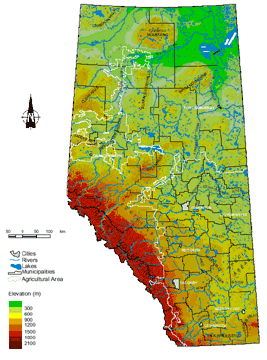| | The purpose of this Agroclimatic Atlas is to present climatic information of importance to agriculture in Alberta and to make that information easily available to the agricultural community including agricultural producers, agribusiness and researchers.
Agriculture today is challenging agricultural producers charged with managing the risks associated with farming and ranching. Changes in technology, climate variability and new options for value-added crops mean producers require more detailed climate, soils and moisture information.
To address these needs, this new edition of the Atlas has been expanded with more agroclimatic maps, a chapter on soil moisture conditions in Alberta and a chapter on the soils and ecoregions of Alberta. These additions are intended to help make agricultural planning and decision-making easier by providing this essential information in one location.
The previous edition, the 1951 to 1980 Agroclimatic Atlas of Alberta by Peter Dzikowski and Richard T. Heywood, was published in 1989 by Alberta Agriculture. Since then, some important strides forward have been made in data quality control and analysis methods.
The maps in the 1951 to 1980 Agroclimatic Atlas were prepared by hand. The maps in this new edition have been created using various computerized mapping techniques that take into account some of the data limitations in terms of the number of stations, the station locations and the station records. For example, in the previous edition, data from some stations had to be adjusted to correct for local inconsistencies and for missing data where the station records were incomplete. The methods used in this new edition remove the need to adjust the data for such problems and allow the use of all available quality controlled daily climate data. (More information on the mapping methods is provided in Interpolation of Climate Station Data.)
The Atlas describes the climate elements relevant to agriculture in Alberta and presents 29 sets of maps of agroclimatic characteristics. The classes on each map are shown using different colours. In general red, orange and yellow colours represent warmer or drier conditions, while green, blue and purple colours represent wetter or colder conditions. The text provides examples to show how the climate information can be used for agricultural purposes. Figure 1 shows locations and physical features mentioned in the text, including cities, lakes, rivers, municipalities, agricultural areas, mountains and hills.
.

Figure 1. Agroclimatic Atlas of Alberta reference map |
|